Hi there! I have been the proud owner of four ex-bats for over four months now (funny how the numbers align  ). I have never kept hens before and it has been quite the learning curve. I'd love to share with you my adventures and experiences into the Ex-Bat world. I'd like to point out that there will be a section on getting Ex-Bats specific to the UK, but the rest of the article can be helpful to anyone!
). I have never kept hens before and it has been quite the learning curve. I'd love to share with you my adventures and experiences into the Ex-Bat world. I'd like to point out that there will be a section on getting Ex-Bats specific to the UK, but the rest of the article can be helpful to anyone!
Components of the article:
- Getting the hens
- First weeks
- Issues
- Chicken bonding
- Coop and run setup
- The hens today
Getting the Hens
So....I live in the UK, over here we have something called the BHWT or the British Hen Welfare Trust, they rehome ex-bats at the end of their commercial life to stop them from, quite frankly, turning into dog food. It is very simple, first timers need to call ahead and the operator will ask you questions about your facilities, you can book any number of hens from 3-40. Or less if you already have some. I drove for about an hour to the collection point armed with a large dog crate with some carpet in the bottom. I recommend carpet in the bottom of the box/cage because it allows them to get some grip when you stop and start when driving. Simple as.
I'm not sure how it works in the US or other countries, even though I lived in Ohio for a while, but, I'd assume there are also rescues/ex-bats there as well.
First Weeks
Well, lets talk about the first minutes first...
We drove for about an hour with the chooks in the dog cage. They didn't make much fuss and only made a few sounds the whole trip. We got home, lifted the cage up to the run and set it down inside. Now, this is where it gets tricky. Ex-bats are going to be confused and terrified. I didn't lift the hens out of the cage but my dad did (I can't say he did the best job sadly). He put his hands in and tried to secure a hen, resulting in much violent flapping and distressed crowing. Next time, I would be much more gentle, slowly putting your hand in and then around the hen's wings. Also, I'd advise a dog cage with a removeable roof, not just a door as it would have made it 10000% easier.
After this we placed them in their coop. I recommend you do this. Place them in the coop and not the run. This allows them to become acquainted with the new world, and is more similar to where they came from, so less distressing. After about 45 minutes they all came down the ramp and were exploring.


Hens in transport.

Hens in their new home.
Issues
You must note that their behaviour is VERY different to 'normal' hens:
- They are originally scared of any loud noises, any movement, the wind, and you too.
- They need to be shown where the feeder and waterer is. Most commercial hens have drip feeders, and you may well not. I dipped my hand in the waterer/feeder and pretended to peck it, showing interest. After withdrawing my hand they came over and proceeded to try to do the same. It really works!
- They have few feathers. Be prepared for this. I suggest collection in summer so that they are warmer. I am in a temperate climate so they don't get cold, which is lucky, however four months on and they still don't have all of their feathers back yet. They rejuvenate at different rates.
- Mine, at least, don't fly like 'normal' hens seem to. They rarely use their wings to jump up onto things and we only had an escapee because of poor coop positioning.
- They don't like perching. Most of the time my hens now sleep on perches, but some still sleep in nesting boxes as they did a lot in the beginning. In addition, we built them a perch outside and some temporary perches. They have never used them. I've only seen them standing on 4 inch high ones for a few minutes before getting off.
- They don't scratch the ground or peck about like 'normal hens'. This comes after a few weeks in my experience.
- Health, some hens will die, it is inevitable. Luckily all hens here are vaccinated and the BHWT never passes on ill hens. That being said, they may still be or get injured.
- Also, when getting ex-bats we check them regularly for any disease or mites/fleas/nits etc. After the first week I 100% suggest you de-mite the coop just in case. Also, worm them.
- Laying in nesting boxes. My hens were laying all over the place, and they still do occasionally now (but only in the coop, not in the mud like they used to). Always put the eggs in the nesting boxes, they get used to it eventually!
-Dust bathing. Out hens began to dust bathe about 2 weeks after we got them.

Betty dustbathing and enjoying the sun!
- Bullying. One of the hens became a bigggg bully and pecked the heck out of the other hens. We fitted her with pinless peepers for 6 weeks until she got them off and she is lovely now! The friendliest of the four hens.

Dottie with pinless peepers on.
- Feather pecking. During their time in the battery farm they will be malnourished and will peck each other's feathers out for nutrients. Our hens stopped naturally after about 3 weeks, but supplements such as 'Chicken Spice' can be given to help out!

Betty with pecked feathers.
- Laying, some ex-bats won't lay or will lay once every blue moon. Luckily my girls lay quite consistently which keeps me stocked up with eggs! Their eggs will probably have deformities, but for me they have been minor so far.
Chicken Bonding
The hens will be very, yes very, afraid of you. Here is what I suggest to try and build a bridge:
- Treats, chickens love treats. Start off by sitting in a low garden chair or on the floor. Put them by your feet, then in your hand, then try stroking whilst they eat from your hand, then try picking them up.
- Spending quality time with them. Sit low to the ground so you don't appear intimidating! Just sit there for 20 mins or more each day and they eventually get quite comfortable with you.
- Talk to them. Chickens, even ex-bats, can read emotions quite well, and they love it when you talk to them softly and calmingly!
Coop and Run Setup
This is more of a guide to a cheap and affordable run.
We were lucky enough to get this coop free from the neighbour's friend. It is only about 3 by 3 feet, but the chickens are fine with it.
We also have some ground sheeting and a used electric fence we got with the electrifier for £60. The ground sheeting makes it harder for the fence to short.
We then built a cover out of recycled 2 by 2's and 1 by 1's that were free. This was eventually fitted with bird netting/chicken wire, with a tarp roof for a sheltered run and also because of the Avian Flu Order, that all chickens needed to be kept inside.
Our feeder and drinkers hang under a homemade, pallet wood little house to prevent water getting in.
To enrich the run we added a perch (which they haven't used).
A black water container for cover (we plan to turn it into a dust bath).
And just a pallet on logs for some fun.
For feed we have 16% layers pellets. Mixed free choice grit with oyster shell and constant water supply. We also bought a 20kg bag of mixed maize as treats.




The run in all its glory!
The Hens Today
After 4 months of looking after these beauties they are well on the road to recover.

Houdini

Betty

Dottie

A very floofy Miranda
Hopefully this helps you get going with your flock of rescue/ex-bat hens!
(please feel free to ask questions below, or PM me, and please do leave a review if you have the time )
)
Components of the article:
- Getting the hens
- First weeks
- Issues
- Chicken bonding
- Coop and run setup
- The hens today
Getting the Hens
So....I live in the UK, over here we have something called the BHWT or the British Hen Welfare Trust, they rehome ex-bats at the end of their commercial life to stop them from, quite frankly, turning into dog food. It is very simple, first timers need to call ahead and the operator will ask you questions about your facilities, you can book any number of hens from 3-40. Or less if you already have some. I drove for about an hour to the collection point armed with a large dog crate with some carpet in the bottom. I recommend carpet in the bottom of the box/cage because it allows them to get some grip when you stop and start when driving. Simple as.
I'm not sure how it works in the US or other countries, even though I lived in Ohio for a while, but, I'd assume there are also rescues/ex-bats there as well.
First Weeks
Well, lets talk about the first minutes first...
We drove for about an hour with the chooks in the dog cage. They didn't make much fuss and only made a few sounds the whole trip. We got home, lifted the cage up to the run and set it down inside. Now, this is where it gets tricky. Ex-bats are going to be confused and terrified. I didn't lift the hens out of the cage but my dad did (I can't say he did the best job sadly). He put his hands in and tried to secure a hen, resulting in much violent flapping and distressed crowing. Next time, I would be much more gentle, slowly putting your hand in and then around the hen's wings. Also, I'd advise a dog cage with a removeable roof, not just a door as it would have made it 10000% easier.
After this we placed them in their coop. I recommend you do this. Place them in the coop and not the run. This allows them to become acquainted with the new world, and is more similar to where they came from, so less distressing. After about 45 minutes they all came down the ramp and were exploring.
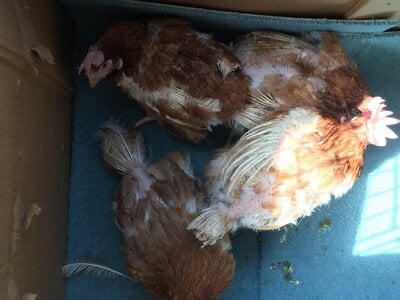

Hens in transport.

Hens in their new home.
Issues
You must note that their behaviour is VERY different to 'normal' hens:
- They are originally scared of any loud noises, any movement, the wind, and you too.
- They need to be shown where the feeder and waterer is. Most commercial hens have drip feeders, and you may well not. I dipped my hand in the waterer/feeder and pretended to peck it, showing interest. After withdrawing my hand they came over and proceeded to try to do the same. It really works!
- They have few feathers. Be prepared for this. I suggest collection in summer so that they are warmer. I am in a temperate climate so they don't get cold, which is lucky, however four months on and they still don't have all of their feathers back yet. They rejuvenate at different rates.
- Mine, at least, don't fly like 'normal' hens seem to. They rarely use their wings to jump up onto things and we only had an escapee because of poor coop positioning.
- They don't like perching. Most of the time my hens now sleep on perches, but some still sleep in nesting boxes as they did a lot in the beginning. In addition, we built them a perch outside and some temporary perches. They have never used them. I've only seen them standing on 4 inch high ones for a few minutes before getting off.
- They don't scratch the ground or peck about like 'normal hens'. This comes after a few weeks in my experience.
- Health, some hens will die, it is inevitable. Luckily all hens here are vaccinated and the BHWT never passes on ill hens. That being said, they may still be or get injured.
- Also, when getting ex-bats we check them regularly for any disease or mites/fleas/nits etc. After the first week I 100% suggest you de-mite the coop just in case. Also, worm them.
- Laying in nesting boxes. My hens were laying all over the place, and they still do occasionally now (but only in the coop, not in the mud like they used to). Always put the eggs in the nesting boxes, they get used to it eventually!
-Dust bathing. Out hens began to dust bathe about 2 weeks after we got them.

Betty dustbathing and enjoying the sun!
- Bullying. One of the hens became a bigggg bully and pecked the heck out of the other hens. We fitted her with pinless peepers for 6 weeks until she got them off and she is lovely now! The friendliest of the four hens.
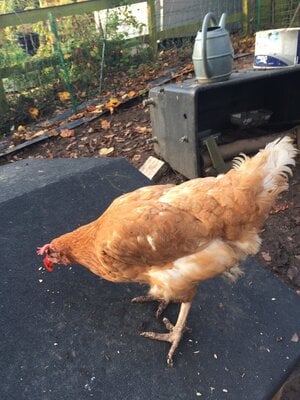
Dottie with pinless peepers on.
- Feather pecking. During their time in the battery farm they will be malnourished and will peck each other's feathers out for nutrients. Our hens stopped naturally after about 3 weeks, but supplements such as 'Chicken Spice' can be given to help out!

Betty with pecked feathers.
- Laying, some ex-bats won't lay or will lay once every blue moon. Luckily my girls lay quite consistently which keeps me stocked up with eggs! Their eggs will probably have deformities, but for me they have been minor so far.
Chicken Bonding
The hens will be very, yes very, afraid of you. Here is what I suggest to try and build a bridge:
- Treats, chickens love treats. Start off by sitting in a low garden chair or on the floor. Put them by your feet, then in your hand, then try stroking whilst they eat from your hand, then try picking them up.
- Spending quality time with them. Sit low to the ground so you don't appear intimidating! Just sit there for 20 mins or more each day and they eventually get quite comfortable with you.
- Talk to them. Chickens, even ex-bats, can read emotions quite well, and they love it when you talk to them softly and calmingly!
Coop and Run Setup
This is more of a guide to a cheap and affordable run.
We were lucky enough to get this coop free from the neighbour's friend. It is only about 3 by 3 feet, but the chickens are fine with it.
We also have some ground sheeting and a used electric fence we got with the electrifier for £60. The ground sheeting makes it harder for the fence to short.
We then built a cover out of recycled 2 by 2's and 1 by 1's that were free. This was eventually fitted with bird netting/chicken wire, with a tarp roof for a sheltered run and also because of the Avian Flu Order, that all chickens needed to be kept inside.
Our feeder and drinkers hang under a homemade, pallet wood little house to prevent water getting in.
To enrich the run we added a perch (which they haven't used).
A black water container for cover (we plan to turn it into a dust bath).
And just a pallet on logs for some fun.
For feed we have 16% layers pellets. Mixed free choice grit with oyster shell and constant water supply. We also bought a 20kg bag of mixed maize as treats.
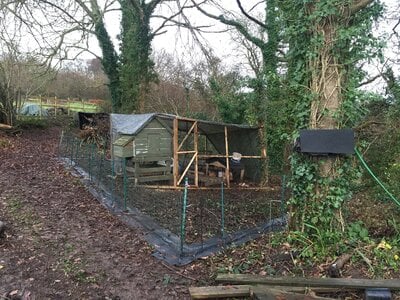
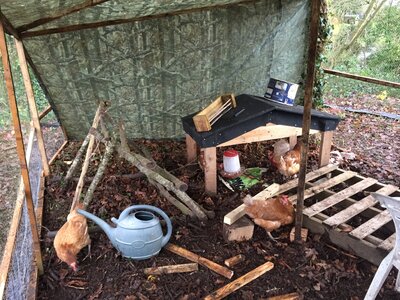


The run in all its glory!
The Hens Today
After 4 months of looking after these beauties they are well on the road to recover.
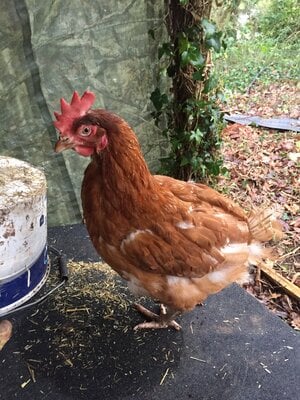
Houdini
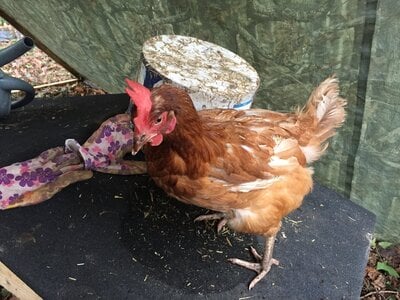
Betty

Dottie

A very floofy Miranda
Hopefully this helps you get going with your flock of rescue/ex-bat hens!
(please feel free to ask questions below, or PM me, and please do leave a review if you have the time
 )
)

